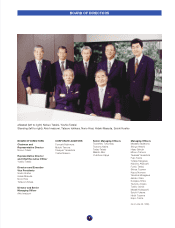Omron 1999 Annual Report Download - page 21
Download and view the complete annual report
Please find page 21 of the 1999 Omron annual report below. You can navigate through the pages in the report by either clicking on the pages listed below, or by using the keyword search tool below to find specific information within the annual report.
19
SALES
During fiscal 1999, ended March 31, 1999, the third and final year of the Seventh Medium-Term Manage-
ment Plan, OMRON focused on achieving three structural reforms, namely, creating a growth-oriented
structure, establishing an innovative cost structure, and revitalizing corporate resources. To these ends,
we strove to improve business performance by developing new products, strengthening our sales
force, and restructuring our various businesses.
In the course of restructuring, we sold a personal computer and peripherals sales subsidiary, our
semiconductor sales business in Japan, and our electronic cash register business in Europe.
However, during the fiscal year under review, a drastic drop in private-sector capital investment,
such as that in the domestic semiconductor industry, and sluggish capital investment overseas led to a
significant decrease in sales by the Control Components and Systems Division. Consequently, OMRON’s
consolidated net sales fell 9.2%, to ¥555,280 million ($4,589 million), from the previous fiscal year.
Increases or decreases in sales by each product group or division are as follows:
The composition of net sales is as follows:
CONTROL COMPONENTS AND SYSTEMS:
Divisional performance was mixed in fiscal 1999. OMRON’s major product group, the Control Compo-
nents and Systems Division, saw a 14.7% drop in net sales compared with the previous fiscal year, due to
the unfavorable business environment created by the stagnant investment conditions in Japan and down-
turns in semiconductor production, machine tool, and measurement control businesses in the United
States as well as sluggish economies in Asia. In contrast, there was a slight sales increase in Europe.
SOCIAL BUSINESS:
The Social Business Division was formed in 1998 by combining the Electronic Fund Transfer Systems
(EFTS) Division and the Public Information and Transfer Systems (PITS) Division into a single division.
Despite an increase in sales by the maintenance and service business of a domestic subsidiary, fiscal
1999 sales by the Social Business Division decreased 1.7% from the previous fiscal year, due mainly to
the decrease in the number of big projects involving public transportation infrastructure, the stagnation
in demand for electronic fund transfer systems in the Japanese market, and the selling off of some
overseas sales subsidiaries.
MANAGEMENT’S DISCUSSION & ANALYSIS
1999 1998 1997
Control Components and Systems ........................................ (14.7)% 7.7% 5.9%
Social Business ...................................................................... (1.7) (4.8) 15.6
Specialty Products ................................................................. 8.6 1.6 20.3
Healthcare .............................................................................. 7.2 12.1 15.1
Open Systems ........................................................................ (36.4) (0.1) 29.9
Others ..................................................................................... 14.6 (11.9) 58.5
1999 1998 1997
Control Components and Systems .......................................... 48.2% 51.3% 49.0%
Social Business ........................................................................ 24.5 22.6 24.5
Specialty Products ................................................................... 9.2 7.7 7.8
Healthcare ................................................................................ 7.9 6.7 6.1
Open Systems .......................................................................... 5.7 8.2 8.4
Others ....................................................................................... 4.5 3.5 4.2
























